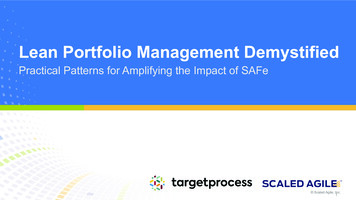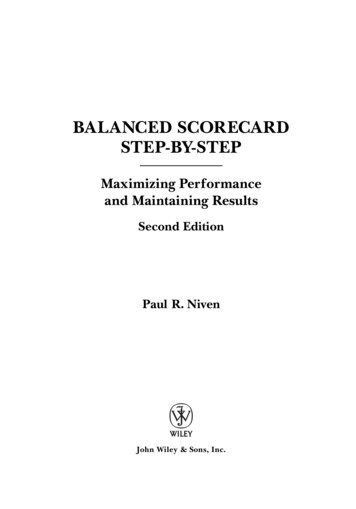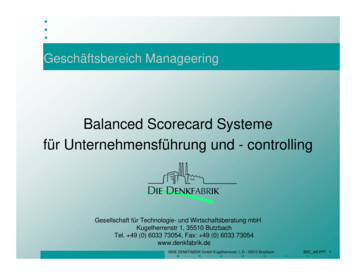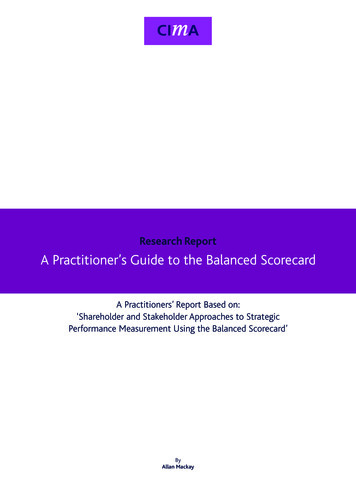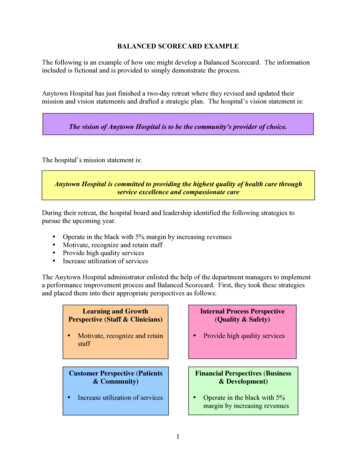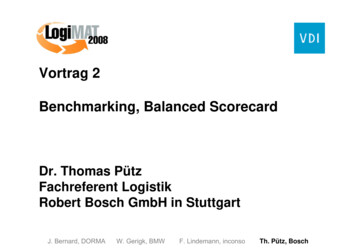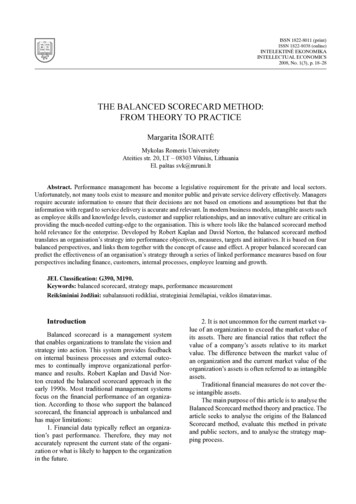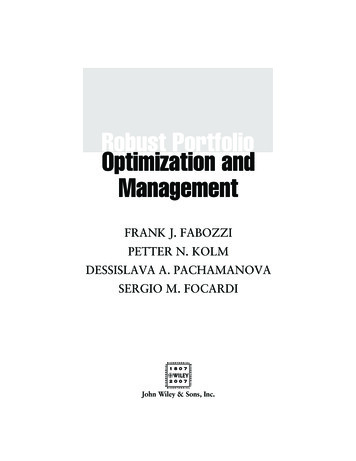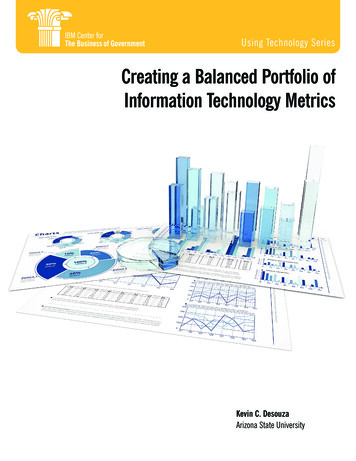
Transcription
Using Technology SeriesCreating a Balanced Portfolio ofInformation Technology MetricsKevin C. DesouzaArizona State University
Using Technology SeriesCreating a Balanced Portfolio ofInformation Technology MetricsKevin C. DesouzaArizona State University2015
Creating a Balanced Portfolio of Information Technology Metricswww.businessofgovernment.orgTable of ContentsForeword. . . . . . . . . . . . . . . . . . . . . . . . . . . . . . . . . . . . . . . . . . . . . . . . . . . . . . . . . . . 4Executive Summary . . . . . . . . . . . . . . . . . . . . . . . . . . . . . . . . . . . . . . . . . . . . . . . . . . . 6An Introduction to Information Technology (IT) Metrics in Government. . . . . . .The Need for Metrics . . . . . . . . . . . . . . . . . . . . . . . . . . . . . . . . . . . . . . .The Challenge . . . . . . . . . . . . . . . . . . . . . . . . . . . . . . . . . . . . . . . . . . . .Federal Performance Management Initiatives: A Brief Historical Review . . . .IT-Specific Performance Management and Metrics Programs in the ObamaAdministration . . . . . . . . . . . . . . . . . . . . . . . . . . . . . . . . . . . . . . . . .8899. . . . . . . 10The State of IT Metrics Today: Challenges and Findings from Interviews . . . . . . . . . . . . 15Challenges . . . . . . . . . . . . . . . . . . . . . . . . . . . . . . . . . . . . . . . . . . . . . . . . . . . . . 15Findings . . . . . . . . . . . . . . . . . . . . . . . . . . . . . . . . . . . . . . . . . . . . . . . . . . . . . . . 17A Framework for Developing a Balanced Portfolio of IT Metrics .IT Metrics to Assess Project Management . . . . . . . . . . . . . .IT Metrics to Assess Operations Management . . . . . . . . . . .IT Metrics to Assess Innovation . . . . . . . . . . . . . . . . . . . . .22222528Recommendations for Developing IT Metrics .Designing an IT Metrics Program . . . . . . .Implementing an IT Metrics Program . . . .Evaluating an IT Metrics Program. . . . . . .31313536.Appendix I: Research Methodology . . . . . . . . . . . . . . . . . . . . . . . . . . . . . . . . . . . . . . . 38Appendix II: Federal Data Center Consolidation Initiative (Core Data Center Metricsand Targets). . . . . . . . . . . . . . . . . . . . . . . . . . . . . . . . . . . . . . . . . . . . . . . . . . . . . . . . 39Acknowledgments . . . . . . . . . . . . . . . . . . . . . . . . . . . . . . . . . . . . . . . . . . . . . . . . . . . 40About the Author . . . . . . . . . . . . . . . . . . . . . . . . . . . . . . . . . . . . . . . . . . . . . . . . . . . . 41Key Contact Information. . . . . . . . . . . . . . . . . . . . . . . . . . . . . . . . . . . . . . . . . . . . . . . 423
Creating a Balanced Portfolio of Information Technology MetricsIBM Center for The Business of GovernmentForewordOn behalf of the IBM Center for The Business of Government,we are pleased to present this report, Creating a BalancedPortfolio of Information Technology Metrics, by Kevin C.Desouza, Arizona State University.Information technology (IT) has made possible the availability ofreal-time data and the tools to display that data, such as dashboards, scorecards, and heat maps. This has boosted the useof data and evidence by government decision makers in meetingtheir agency and program missions. But what about the use ofperformance metrics by chief information officers (CIOs)themselves?Daniel J. ChenokTypically, CIOs have a good inventory of metrics regarding theperformance of their technical infrastructure, such as serverdowntime. Metrics on nontechnical elements, however—such asinnovation capacity of the IT department and the health of theoverall IT organization—are in earlier stages of development.These metrics are critical for CIOs to have in order to managetheir IT departments, build a broader base of support for ITinvestments, and convey the strategic value of IT assets forattaining agency-wide objectives.Professor Desouza argues that a balanced portfolio of metricsis needed for project management, operations management,and innovation in order to effectively deliver on agency missionobjectives. The author interviewed over two dozen federal, state,and local government CIOs to find out the types of metrics theyfound most useful, and the challenges they face in leveragingmetrics effectively. Desouza synthesizes findings and makesthem readily accessible to nontechnical readers, and makesrecommendations for designing, implementing, and evaluatingIT metrics programs.Technology leaders at the federal level are creating processesand systems to ensure that IT metrics are integrated into broaderagency decision-making processes. Since 2009, for example,4David A. Hathaway
Creating a Balanced Portfolio of Information Technology Metricswww.businessofgovernment.orgfederal agencies have followed guidance from the Office ofManagement and Budget in holding TechStat meetings on a regular basis to assess the progress of new IT investment projects,and have also developed IT Dashboards and PortfolioStat. ITmetrics that are tied to agency mission performance can clearlydemonstrate the benefits of sound IT investments. Based on hisresearch, Desouza concludes that a balanced portfolio of metricscan help agency CIOs to capture the progress and value of ITinvestments to the overall organization.We hope the framework and insights offered by Desouza areuseful to CIOs, IT managers, and agency executives. As Desouzanotes, government IT leaders need now to be part of “a new eraof government performance management that is data-driven,constantly evolving, and optimized.”Daniel J. ChenokExecutive DirectorIBM Center for The Business of Governmentchenokd @ us.ibm.comDavid A. HathawayVice President, IBM FederalApplication Development and Innovationdavid.hathaway @ us.ibm.com5
Creating a Balanced Portfolio of Information Technology MetricsIBM Center for The Business of GovernmentExecutive SummaryGiven the growing dependance on information technology (IT) for service delivery and theaccomplishment of mission objectives and the trend of increasing spending on IT, it is important that we have tools and techniques in place to develop a balanced portfolio of measuresof IT performance which include IT project management, IT operations management, andIT innovation.This report investigated the state of the use of IT metrics in the public sector. The projectreviewed literature across diverse fields such as management sciences, information systems,public administration and management, and operations management to examine the stateof-the-art approaches to the use of metrics for IT in the public sector. The project analyzedstrategic plans from federal and state government IT offices to understand how metrics werecaptured in these formal plans.Twenty-seven chief information officers (CIOs) and/or IT directors were interviewed on theiruse of metrics to manage IT departments, personnel, infrastructure, projects, and innovation.The interviews identified four challenges: Challenge One: Many IT metrics will depend on other organizational units meeting theirperformance targets Challenge Two: IT metrics require a focus on long-term planning Challenge Three: CIOs will need to coordinate efforts to integrate metrics and developstandards for comparison Challenge Four: IT departments must have the ability to collect real-time data on IToperationsThe report found that CIOs recognize and understand the value of metrics. CIOs have createdprograms to support the collection, analysis, and communication of data on IT programs, butare challenged to find the time and resources to implement comprehensive performance management programs within their departments. This report presents 14 recommendations fordesigning, implementing, and evaluating IT metrics:Designing an IT Metrics Program Recommendation 1: Set clear goals before selecting metrics Recommendation 2: Develop a strategic IT plan linked to agency strategic goals Recommendation 3: Engage internal and external stakeholders in the developmentof metrics Recommendation 4: Collect baseline data on performance Recommendation 5: Avoid “watermelon” metrics6
Creating a Balanced Portfolio of Information Technology Metricswww.businessofgovernment.org Recommendation 6: Select fewer and less-complex metrics Recommendation 7: Design and build dashboards that capture metrics Recommendation 8: Do not focus exclusively on IT infrastructure MetricsImplementing an IT Metrics Program Recommendation 9: Communicate regularly and often with key stakeholdersabout metrics Recommendation 10: Keep metrics updated Recommendation 11: Use metrics to set targets Recommendation 12: Keep an eye out for people gaming the metricsEvaluating an IT Metrics Program Recommendation 13: Revise metrics periodically Recommendation 14: Seek continued renewal and improvement7
Creating a Balanced Portfolio of Information Technology MetricsIBM Center for The Business of GovernmentAn Introduction to InformationTechnology (IT) Metrics inGovernmentThe Need for MetricsInformation technologies (ITs) are critical assets in all aspects of the public sector. The criticality of designing, implementing, and maintaining IT assets in an effective and efficient mannercannot be underestimated. Over the last few years, spending on IT has increased across allthree levels of government (federal, state, and local), and most observers expect this trend tocontinue.Given this growth in spending and the critical connection of IT to the operations and successof public agencies, we hear a limited number of success stories on how IT has helped transform agencies, deliver service more optimally, save taxpayer resources, and even lead innovation efforts to address vexing social challenges. We are more likely to hear about IT projectsthat have “gone rogue” and failed to deliver on their promises.One possible cause for these problematic IT projects is that the chief information officer (CIO)community has not done enough to invest in the creation of metrics that capture the performance of IT assets and their contribution to organizational performance. Building performancemanagement processes and capabilities requires CIOs to invest time and effort to capture,validate, analyze, and share data on metrics. In the absence of credible information on ITperformance, anecdotal evidence about IT failures is likely to dominate the discussion of ITperformance in the public sector. With the availability of IT performance metrics, CIOs canboth proactively manage performance and demonstrate mission results.Metrics identify organizational priorities and measure the performance of those priorities. Metricsshould track performance and guide operational and strategic decisions. The GovernmentAccountability Office (GAO) and the Office of Management and Budget (OMB) have extolledthe need for quality IT metrics in government to measure and assess the effectiveness andviability of IT projects.Despite repeated calls, much work is needed when it comes to infusing metrics into the management of IT departments, projects, and processes. In a 2013 Congressional hearing onreducing duplication and improving IT outcomes, Senator Tom Coburn acknowledged that, ingovernment IT “ we do not have real transparency and metrics on what we are doing.”1 Atthe same hearing, Steven VanRoekel—then federal Chief Information Officer and Administratorfor E-Government and Information Technology—acknowledged that “sound management isrooted in evidence, metrics, data, and incentives.”1.Senate Hearing 113-97 on reducing duplication and improving outcomes in federal information technology. (June 2013). U.S.Congress. Committee on Homeland Security and Governmental Affairs, Washington, D.C. Retrieved April 29, 2015, HRG-113shrg82569.htm.8
Creating a Balanced Portfolio of Information Technology Metricswww.businessofgovernment.orgThe ChallengeIn light of very public IT failures at each level of government, the time now appears ripe for further improvement in the management of IT projects with the development of IT metrics. Thereare efforts under way to modernize policies and procedures when it comes to IT managementand the role of the CIO. The challenge is that IT projects are highly complex. Government nowis attempting to better manage that complexity. Part of the response to this complexity hasbeen the increased emphasis on developing metrics to measure current IT performance. Asgovernment deals with the challenge of IT and organizational complexity, its response has beento enact stronger performance management tools such as metrics. Metrics should be used tomeasure current performance, as well as to signal opportunities for improvement.It is evident from examples from across the country that public agencies’ use of metrics for ITprojects is largely inconsistent. Attempts to standardize metrics have been made, but bureaucratic resistance often prevents metrics from being implemented in a systematic fashion acrossorganizations. Despite repeated mandates for a stronger focus on metrics, many public agenciesare still struggling with designing, implementing, and using high-quality metrics.In a February 2015 audit of 20 Department of Defense (DoD) major automated informationsystems—which include communications, business, command, and control systems—GAOfound that 12 out of 20 programs did not have cost and performance metrics in place withinthe first two years of the programs. GAO found that it took the DoD, on average, five yearsand two months, and 452 million, to establish baselines for life cycle cost, scheduling, andperformance targets.2In spite of the challenges, complexity, and inconsistency, a focus on metrics is important.Metrics are needed to increase transparency of operations, track progress, spur innovation, andunderstand places for improvement. Nicholas Carr wrote in his famous and highly debatedpiece, “IT Doesn’t Matter,” in the Harvard Business Review that IT has become so commoditized that there are few competitive advantages that can be garnered from new technologies.3Obviously, public agencies are not in the business of seeking competitive advantages. However,imagine a situation in which CIOs are questioned on the value of IT. What evidence will CIOsuse to make the case that IT does matter in the public sector? How will CIOs show that ITinvestments, coupled with disciplined management, can lead to transformative outcomes foran agency, optimize delivery of services, and increase effectiveness when it comes to theattainment of organizational objectives?Federal Performance Management Initiatives: A BriefHistorical ReviewOver the past 50 years, the federal government has made efforts to modify performancemanagement practices (largely revolving around budget practices) to focus more on metrics.However, few have stood the test of time. The reforms include: In 1965, President Lyndon B. Johnson introduced the Planning-Programming-BudgetingSystem (PPBS) that integrated multiple planning and budgeting techniques to identifycosts and complexities in order to forecast costs.42.Defense major automated information systems. (February 2015). GAO, Washington, D.C. Retrieved April 7, 2015, from www.gao.gov/assets/670/668718.pdf; Trinity returns, DCS debuts, senators back IGs and DoD metrics. (February 26, 2015). Retrieved April 7,2015, from -26.aspx.3.Carr, N. (May 2003). IT doesn’t matter. Harvard Business Review. Retrieved April 7, 2015, from https://hbr.org/2003/05/it-doesntmatter.4.The American presidency project. (August 25, 1965). Retrieved April 7, 2015, from www.presidency.ucsb.edu/ws/?pid 27182.9
Creating a Balanced Portfolio of Information Technology MetricsIBM Center for The Business of Government In 1973, President Richard M. Nixon initiated Management by Objectives (MBO) thatemphasized participative goal setting and actual performance measurement.5 In 1977, President Jimmy Carter introduced Zero-Based Budgeting (ZBB) that focusedbudgeting on the measurement of need rather than on historical allocations.6Each was well intentioned, with the goal of improving performance management practices.Each of these reforms has been judged to have failed either due to poor implementation or tosimply being allowed to fall by the wayside.In the 1990s, Congress passed performance management legislation that would have stayingpower. In 1993, Congress passed the Government Performance and Results Acts (GPRA) toimprove stewardship of public resources by linking resources and management decisions withprogram performance.7 Although not specifically developed for IT, the GPRA created a foundation for performance measurement in the public sector that would impact future IT projects.The GPRA required agencies to: Develop comprehensive five-year strategic plans, complete with outcome-based goalsand objectives Delineate annual performance plans to explicate the operational processes, skills,technology, and resources required for each program or activity Prepare year-end reports to compare the actual performance with the plan for thefiscal year8In 2010, the GPRA was extended and was transformed into the GPRA Modernization Act of2010 (GPRAMA).9 The GPRAMA requires OMB to coordinate with other federal agencies todevelop long-term, outcome-oriented goals every four years in cross-cutting policy areas.Annually, OMB must now provide information on how these goals will be achieved. To ensurethat performance data is used and not just collected, the GPRAMA requires goal leaders tocomplete quarterly reviews of priorities called Cross-Agency Priority (CAP) goals.10 CAP is atool for leadership to achieve success in priority areas that require collaboration between multiple agencies. One of the 15 CAP goals focuses on benchmarking. The aim of this CAP goalis to improve administrative efficiency and effective management by establishing cost andquality benchmarks in five areas, one of which is IT. The IT benchmarking initiative is discussed further on page 13. (The other four benchmark areas are human capital, financialmanagement, acquisitions, and real property.)IT-Specific Performance Management and Metrics Programs in theObama AdministrationOMB plays a key role in the development and oversight of federal investments into IT by working with agencies to plan, justify, and determine how to manage their portfolios. OMB alsoassists agencies in developing business cases for potential IT investments and establishes5.Kelly, J. M., & Rivenbark, W. C. (2014). Performance budgeting for state and local government. London, UK: Routledge.6.Zero-based budgeting. (July 1977). Office of the Librarian, Washington, D.C.7.Government Performance and Results Act of 1993. (Public Law 103-62).8.Radin, B. A. (1998). The Government Performance and Results Act (GPRA): Hydra-headed monster or flexible management tool?Public Administration Review, 307-316.9.GPRA Modernization Act of 2010. (Public Law 111–352).10. GPRA Modernization Act provides opportunities to help address fiscal, performance, and man
Portfolio of Information Technology Metrics, by Kevin C . Desouza, Arizona State University . Information technology (IT) has made possible the availability of real-time data and the tools to display that data, such as dash-boards, scorecards, and heat maps . This has boosted the use of data and evidence by government decision makers in meetingFile Size: 1MB
